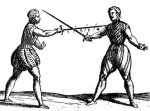Tournament Format for King’s and Queen’s Rapier Championships
 The conventions and format for the upcoming King’s and Queen’s Rapier Champions Tournament have been announced by Don Nathaniel Wyatt, King’s Rapier Champion. Any authorized rapier fighter may enter the tournament, but those wishing to compete for the Championships must affirm that they are willing and able to perform the duties when they sign in with the Mistress of Lists and only those individuals will advance into the sweet sixteen.
The conventions and format for the upcoming King’s and Queen’s Rapier Champions Tournament have been announced by Don Nathaniel Wyatt, King’s Rapier Champion. Any authorized rapier fighter may enter the tournament, but those wishing to compete for the Championships must affirm that they are willing and able to perform the duties when they sign in with the Mistress of Lists and only those individuals will advance into the sweet sixteen.
The follow are the details of the tournament as described by Don Wyatt on the East Kingdom Rapier website.
First, conventions for the day.
Single Rapier: For the purposes of this tournament, single rapier will be defined as a single sword which is clearly intended to be used one handed. If there is any disagreement on the day of the tournament as to whether a weapon qualifies, I will be happy to make the determination on the spot. I hope, however, that the spirit of this ruling is clear.
Offensive Weapon Form: For the purposes of this tournament these fighting forms consist of rapier and dagger, case of rapier, and two-handed sword.
Defensive Weapon Form: For the purposes of this tournament these fighting forms consist of rapier and rigid parry, and rapier and non-rigid parry.
Double Kills: In the Round Robin double kills will be re-fought once per pairing. After that, dead is dead and the pass will be recorded as a loss for both combatants.
Re-centering in the List: We will not be re-centering fighters when they hit the ropes. We expect that if you have placed yourself in a corner, you must want to be there and the fight will continue as such.
Tournament Format
As has become common, the tournament will consist of three parts – the round robin, the sweet sixteen, and the finals. There will be 8 pools.
Part One – Round Robin: Fencers will be divided into eight pools of a size based on the number of combatants. Each fencer in a pool will fight two bouts against all of the other fencers in their pool (see note below). The second bout will be fought immediately following the first without exiting the list. Each fencer must fight one of the passes using an offensive form and the other of the passes using a defensive form or single rapier. There is not a sequence requirement for the form selection. Just that it must be done. There is not a requirement to match forms in either pass. Points will be awarded as follows:
- Winning only the first pass: 3 points.
- Winning only the second pass: 2 points.
- Winning the first and second pass: 4 points.
- Double kills: 0 points.
The top two fighter(s) in each will be selected to advance to the sweet sixteen.
NOTE: In the event that we have more than 87 competitors the Round Robin will have to be a single pass per pairing within the pools. This is due to the estimated time requirement to complete Part One given the number of fencers. If this situation occurs the scoring will be changed to one point per pairing and fencers will be required to use a Defensive Weapon Form or Single Rapier.
Part Two – Sweet Sixteen: This will be a double elimination tree. Each pairing will consist of the best of three bouts. For each bout within the pairing, the fighters must choose one of single rapier, an offensive form, and a defensive form. Fighters may not repeat from among these three categories within a given pairing. Fighters are not required to match forms. If fighters are not able to agree on the sequence of the forms a call and respond will take place with the first call decided on a coin flip.
Part Three – Finals: The winner of the Winner’s Bracket and the winner of the Loser’s Bracket will advance to the finals. The finals will be decided as a best of five bouts. Before the finals begin, each fighter will lay out their chosen five weapon selections. While each of these must be substantially different from each other, they need not align with the weapon authorizations we’ve all come to know and love. For instance, rapier and stick is considered to be different from rapier and buckler; two different bucklers or two different stick-like objects are not different. A single-handed rapier is different from a two-handed rapier. If there are questions as to whether something is “substantially different,” I’m happy to field them over email off-list or at the tournament.
This does mean that a fighter could, for example, lay out: Rapier and Dagger, Rapier and Stick, Rapier and Buckler, Two Handed Sword, Case of Rapier.
The fighters will be able to look over the weapon selections of their opponent and we will ensure that they are all acceptable to both combatants. The fencer coming out of the winner’s bracket gets the option of call or response in the first pass. The fencers will alternate call/response for the remaining passes.
